Hollandaise Vs Bearnaise Sauce: What's The Difference?
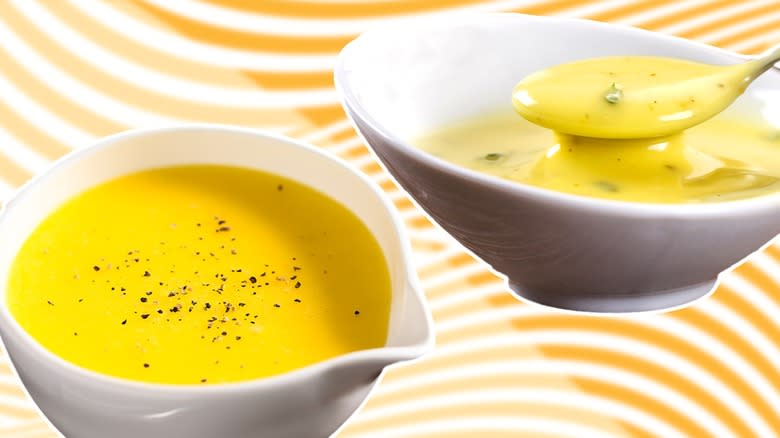
Hollandaise and bearnaise are two sauces with more than just fancy-sounding names. They're staples of French cuisine, and the late great, classically French-trained Anthony Bourdain had strong opinions about both of 'em. Hollandaise, made in part by combining egg yolks and butter, could turn your stomach if not held at the right temperature during a restaurant brunch rush, as he explained in "Kitchen Confidential." The latter sauce came up in an episode of "A Cook's Tour" filmed at Les Halles Brasserie, the French restaurant at which he used to be the executive chef. During the dinner rush, Bourdain reacted to one particularly perplexing customer request: "No butter?! 'No butter,' but they want 'extra bearnaise?!' What's the matter with these ... What the h**l do you think bearnaise is? Bearnaise is like, egg yolks and butter!"
The point is, for such stripped-down, physically pale, minimal-ingredient sauces, hollandaise and bearnaise are kind of a big deal -- and they are not (we repeat not) interchangeable. There's a lot to talk about. For instance, while they have short lists of ingredients, many of them are the same. So, what makes them different? They can be distinguished by their sources of acidity, specific elements of their preparations, and how they are used.
Read more: The 20 Best Olive Oils For Cooking
What Is Hollandaise Sauce?
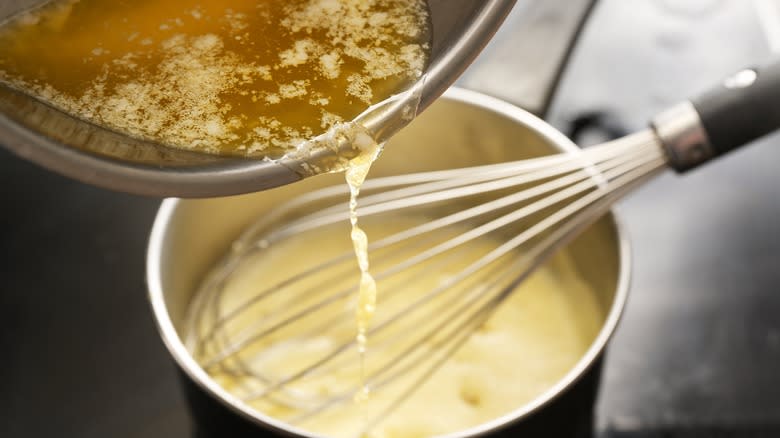
Hollandaise sauce is one of the five mother sauces of French cuisine, along with béchamel, velouté, espagnole, and sauce tomat. But, unlike sauce tomat, hollandaise is a fat-in-water emulsion, and emulsified sauces are notoriously tough to get right. Butter and water do not naturally want to mix together. Egg yolks contain lecithin, which acts as an emulsifier, holding these French sauces together. But, if your pan is too hot then the egg yolks cook into scrambled eggs, and if it's too cold then your sauce stays thin and your butterfat crystallizes, and either way the emulsion is broken and your sauce is ruined (it's all quite dramatic).
Made successfully, hollandaise sauce is made from a base of cool egg yolks and warm butter, flavored with black peppercorns, salt, lemon juice, and cayenne pepper. More specifically, hollandaise is all about the lemon juice and clarified butter. When butter is clarified, the milk solids are stripped away, leaving behind a golden butter product that can be heated to 450 degrees Fahrenheit without smoking (compared to regular butter's 350 degree smoke point), which is essential for achieving a lush, buttery pan sauce. This higher smoke point makes finicky emulsions (like hollandaise) more stable and less prone to breaking. From there, the clarified butter and lemon juice are slowly whisked into egg yolks at a low temperature to assemble the hollandaise sauce.
What Is Bearnaise Sauce?
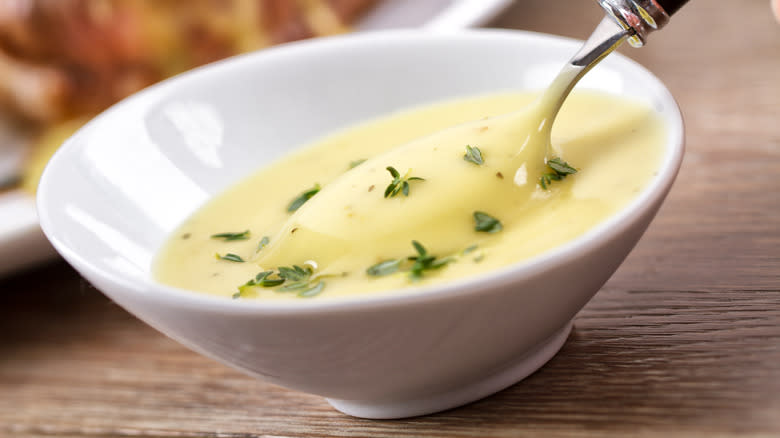
Bearnaise sauce is made from a reduction of white wine vinegar and dry white wine. The addition of shallots and tarragon imparts savory, rounded flavor -- as well as class, panache, and the implication of a fabulous dry laugh. Bearnaise sauce is named after the French region of Béarn (although, the sauce's name-origin lore is kind of a long story). It sports a pale yellow hue dotted with chopped fresh herbs, primarily savory tarragon and sometimes chervil. Chervil tastes like tarragon-meets-parsley plus a mild anise flavor, and it's wicked popular in classic French dishes. Tarragon is a highly aromatic herb with a bold, savory licorice flavor, which earned it the nickname "the king of herbs" in French cuisine. Tarragon and chervil are also two of the four classic French "fines herbs," along with parsley and chives.
Technically, you can make it in a blender, but the traditional preparation of bearnaise sauce involves using a double boiler, which reduces the liquid and gently heats the egg yolks. It's a similar technique to how hollandaise is made. The chief difference is that, with bearnaise, vinegar, wine, shallots, tarragon, and peppercorns are boiled together separately in a saucepan into a reduction, then slowly incorporated into the butter and egg yolk emulsion.
Hollandaise Is Bright And Light While Bearnaise Is Savory And Herbaceous
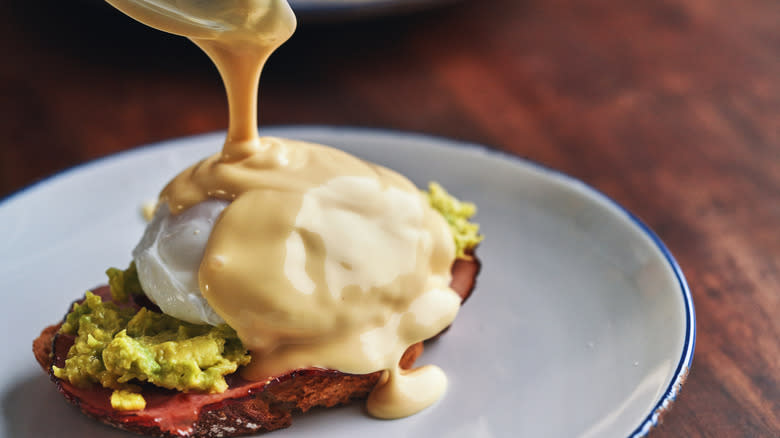
In the realm of French cuisine, bearnaise is actually a secondary sauce of the hollandaise maternal lineage. So, you could say that the apple didn't fall far from the tree -- but you could not say that the apple and the tree achieve the same purpose. For these lush, silky sauces, there are no substitutes (well, there actually are a few decent substitutes, but we won't get into that here).
Both sauces feature an element of acid to balance the richness of the creamy sauce. But, whereas hollandaise contains lemon juice, bearnaise is made with white wine vinegar. Naturally, by extension, this difference in ingredients also creates different flavor profiles. Hollandaise may be custardy in texture, but the taste is light and bright. If you add a little blood orange, it becomes Maltaise sauce. Comparatively, bearnaise is more tangy from the addition of the vinegar, with earthy depth from the herbs.
In short, if hollandaise is lemony, then bearnaise is herby. As the gastronomic child of hollandaise, it includes most of the same ingredients as its parent sauce, plus shallots, tarragon, and wine. For a punchy, ultra-savory umami upgrade, you could even stir a dollop of miso paste into your bearnaise sauce (we won't tell the haute cuisine elitists).
Hollandaise Sauce Is Served With Lighter Meats While Bearnaise Sauce Walks On The Heavier Side
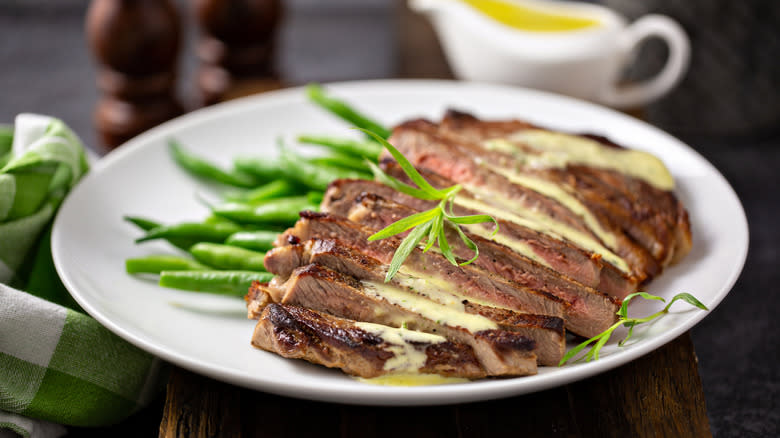
Skip the gelatin-packed demi-glace in other French steak sauces like espagnole. Both hollandaise and bearnaise sauces are emulsions, bound and thickened with egg yolks. They may be prepared roughly the same way, but thanks to their different tastes, these thick, smooth sauces accomplish different tasks in the culinary world. Hollandaise sauce is traditionally served over lighter entrees like roasted vegetables (especially asparagus), poultry dishes, and fish. It's a crucial part of Eggs Benedict and Eggs Florentine (which are not to be confused with one another), but it's also wicked versatile, and great over baked potatoes.
Bearnaise sauce shares hollandaise's custardy body, but its extra acidity and dryness from the wine and vinegar work well for cutting through heavier meats. For these reasons, bearnaise is traditionally draped over beef dishes and heavier grilled meats or whole roasted tenderloin. Its most common utilization in the kitchen is as a lush blanket over a plated steak, but its herbaceous flavor also makes it a delicious dipping sauce for garlic bread or French fries (we're lookin' at you, steak-frites lovers).
Read the original article on Tasting Table


